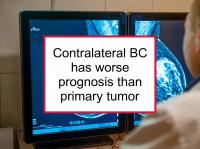Contralateral breast cancer refers to a tumor in the untreated, or opposite, breast. Women diagnosed with breast cancer in one breast are at increased risk of developing breast cancer in the opposite breast. It can be difficult to tell whether such cancer is a distant metastasis of the original tumor or a new primary tumor.
Not surprisingly, the prognosis is worse for contralateral breast cancer occurring within two years of the original tumor. Now a new study has reported that the prognosis of women who develop contralateral breast cancer is relatively unfavorable, suggesting that this factor should help inform treatment decisions.
Factors associated with increased risk of contralateral breast cancer
The risk of developing contralateral breast cancer after being treated for breast cancer is approximately 60% higher than the risk of developing breast cancer in the first place. Generally speaking, factors associated with increased breast cancer risk are also associated with increased risk of contralateral breast cancer. However, the following factors have been studied and found to be specifically associated with heightened risk of contralateral breast cancer:
- Aggressive breast cancer subtype (triple negative, HER2 positive, or inflammatory breast cancer)
- Strong family history of breast cancer (including BRCA mutations)
- Multiple positive lymph nodes
- Lobular breast cancer or low grade (grade 1) tumor in the absence of long-term use of endocrine treatment
- History of type 2 diabetes
- Childlessness, combined with radiation treatment to the contralateral breast
- Consumption of at least seven alcoholic beverages per week.
Latest research: Lower survival among women with contralateral BC
The study referenced at the beginning of this news article was designed to investigate risk factors for contralateral breast cancer, as well as corresponding breast cancer-specific survival. The study included 42,670 Swedish women who developed breast cancer between 1992 and 2008. Breast cancer-specific survival for women with contralateral breast cancer (that was not diagnosed at the same time as the primary tumor) was compared to results for women with unilateral breast cancer (i.e., in one breast only).
Women with at least 10 positive lymph nodes were found to have 1.8 times the risk of contralateral breast cancer as those with negative lymph node status. The prognosis was less favorable among women with contralateral breast cancer compared to those with unilateral breast cancer. The risk of dying from contralateral breast cancer diagnosed up to five years after the original diagnosis was 2.3 times the risk of dying from unilateral breast cancer. The risk of dying from breast cancer was highest for women with a short time interval from the original breast cancer diagnosis. The risk of death gradually declined with longer follow up, but remained higher than the risk originating from an original primary tumor for more than 10 years.
The authors conclude that women with advanced-stage primary breast cancer have a heightened risk of developing contralateral breast cancer. In addition, the development contralateral breast cancer is associated with a greater risk of dying from breast cancer throughout a long period of follow up after the original primary tumor. The findings suggest that contralateral breast cancer marks a new clinical situation in terms of investigations for metastases, treatment considerations, and follow-up strategy, according to the authors.
